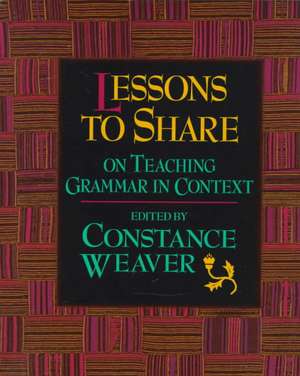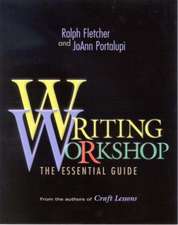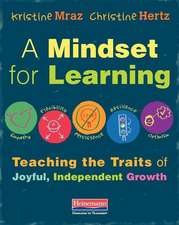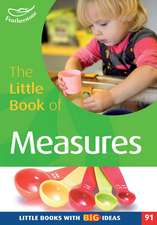Lessons to Share on Teaching Grammar in Context
Autor Weaver Editat de Constance Weaveren Limba Engleză Paperback – 31 ian 1998 – vârsta de la 11 până la 17 ani
With "Teaching Grammar in Context," thousands of teachers discovered why students achieve better results when they learn grammar during the process of writing. In "Lessons to Share," Connie Weaver's promised sequel, she focuses on the practical, offering valuable "lessons" from educators at all levels.
The first section of the book addresses the learning and teaching of grammar, setting the stage for subsequent sections. The purpose behind the article on how language is learned is to help readers understand that babies and preschoolers acquire the grammar of their language without direct instruction and that language continues to develop indirectly during children's school years. Connie's article on teaching grammar in the context of writing articulates other aspects of the rationale that underlies this book: teaching grammar in the context of its use.
The second and major section deals with teaching grammar through writing, across the grades. The authors address punctuation, parts of speech, effective word choice and syntax, and conferencing with students to teach revision and editing. The next section focuses on style, with emphasis on sentence composing, "image grammar," and "breaking the rules" for stylistic effect. There is also a discussion of the power of dialects and the dialects of power. The last section deals with teaching the English language and its grammar to ESL students in kindergarten through college. The section and book conclude with an article on using grammar checking computer software.
Preț: 377.76 lei
Nou
72.28€ • 75.67$ • 59.81£
Carte disponibilă
Livrare economică 15-29 martie
Specificații
ISBN-10: 0867093943
Pagini: 336
Dimensiuni: 187 x 238 x 15 mm
Greutate: 0.55 kg
Editura: Heinemann Educational Books
Descriere
The first section of the book addresses the learning and teaching of grammar, setting the stage for subsequent sections. The purpose behind the article on how language is learned is to help readers understand that babies and preschoolers acquire the grammar of their language without direct instruction and that language continues to develop indirectly during children's school years. Connie's article on teaching grammar in the context of writing articulates other aspects of the rationale that underlies this book: teaching grammar in the context of its use.
The second and major section deals with teaching grammar through writing, across the grades. The authors address punctuation, parts of speech, effective word choice and syntax, and conferencing with students to teach revision and editing. The next section focuses on style, with emphasis on sentence composing, "image grammar," and "breaking the rules" for stylistic effect. There is also a discussion of the power of dialects and the dialects of power. The last section deals with teaching the English language and its grammar to ESL students in kindergarten through college. The section and book conclude with an article on using grammar checking computer software.
Cuprins
How Language Is Learned: From Birth Through the Elementary Years and Beyond, J. Kiel
Teaching Grammar in the Context of Writing, C. Weaver
Grammar Through Writing, Across the Grades
Learning to Punctuate Sentences in the Elementary Grades, P. Cordeiro
Teaching Writing and Grammar in Context, S. Peterson
Facilitating the Use of Description-and Grammar, S. Woltjer
Using Mini-Lessons to Promote Student Revision: Helping Students Realize Their Power over Words, S. Rowe
When Grammar Matters: Guiding Students Through Revision, R. Callies
Learning to Use Grammar with Precision Through Editing Conferences, E. Brinkley
Developing Correctness in Student Writing: Alternatives to the Error Hunt, L. Rosen
Image Grammar, H. Noden
Teaching Style and the Use of Grammar for Rhetorical Effect and Appropriateness
Sentence Composing: Notes on a New Rhetoric, D. Killgallon
Breaking the Rules in Style, T. Romano
The Power of Dialect: Ebonics Personified, D. Troutman-Robinson
Ebonics and the "Parsley" Problem: Personal Reflections, C. Weaver
Special Populations and Situations
Meeting the Special Needs of English as a Second Language (ESL) Students in Public Schools, M. Loewe
Implementing Whole Language in a University-Level ESL Curriculum,
M. Loewe
Preparing Teachers to Teach About Language, D. & Y. Freeman
Between Teachers and Computers: Does Text-Checking Software Really Improve Student Writing?, T. Beals










